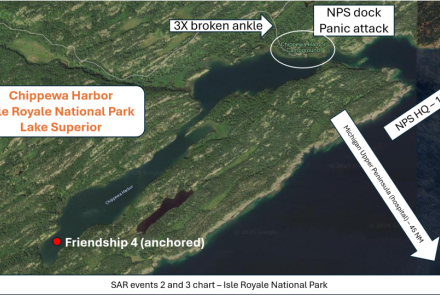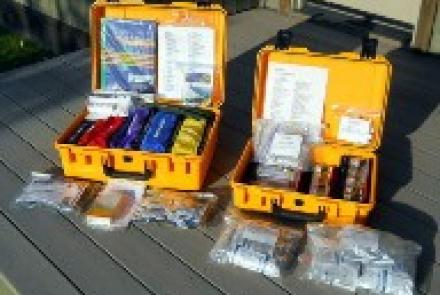Lithium Batteries, A few notes
Lithium Battery Notes
Stan Honey
November 2024
CCA
There is a well-researched review of lithium-ion battery safety from the FAA which is available to the public: https://www.fire.tc.faa.gov/pdf/TC-16-17.pdf
Here is an excerpt from the summary:
In general, of all of the lithium-ion cells that were tested, LiFePO4 would be considered the safest cathode material because of the relatively low temperature rise and the resulting low likelihood for thermal runaway to propagate. LiCoO2 and LiMnNi would be considered the most hazardous because of the relatively large temperature rise and high probability for propagation of thermal runaway to adjacent battery cells.
In this note there are separate recommendations for Lithium Iron Phosphate (LiFePO4 or LFP) batteries which are generally used in house banks, and portable devices which use other chemistries such as Lithium Cobalt Oxide (LiCoO2). As the FAA report concludes, LFP is the safest of the lithium-ion chemistries. It is also the least efficient. The energy storage efficiency of LFP, by weight or volume, is about half that of LiCoO2, which is why LiCoO2 is used in phones, tablets, laptops, and tools.
LFP
Large “house” lithium-ion battery banks on boats nearly always use LFP.
LFP cells can be short-circuited, overcharged, crushed, and subjected to severe external heat without entering violent thermal runaway, without propagating thermal runaway from one cell to another, and without setting themselves on fire. When mistreated they bloat and emit an oddly sweet-smelling gas.
The best-engineered, longest-life, and safest LFP installations will result from purchasing an entire system from one of the major manufacturers, and having it professionally installed. Victron is currently the most prevalent vendor of high-end systems although Mastervolt and Lithionics are also good choices. It is best to buy not only the LFP batteries but also the BMS, monitoring system, alternator regulator, solar charge controllers, and shore charger, from the same vendor so that all are compatible and can communicate with one another.
If you want to use “drop-in” LFP batteries, carefully consider the configuration of all charge sources to comply with the battery manufacturer’s recommendation. Also consider the peak current capacity of the drop-in batteries, which may be limited by an internal FET based BMS.
ABYC E-13 provides some useful recommendations for safe installations of LFP batteries. Highlights include:
- The LFP battery shall have a Battery Management System (BMS) that can cut off the battery if hazardous conditions exist. These conditions include cell over voltage, cell under voltage, over current, and over temperature.
- The possibility of the LFP battery being cut off with no notice shall be considered in the design of a boat’s electrical system. If battery is cut off while accepting significant current from an alternator, the alternator current, without the “sink” of the connected battery, creates a high voltage “load dump” transient that can destroy electronics on the boat as well as potentially the diodes in the alternator. There are various solutions that can be used to eliminate this risk.
- LFP batteries shall have overcurrent protection with interrupting capacity sufficient for the battery (e.g. a class T fuse).
- LFP batteries shall be physically installed to prevent any visible movement.
See the ABYC E-13 spec for more requirements.
Beyond the ABYC specification, here are some additional suggestions:
- Take careful consideration of the peak (stall or startup) currents from a windlass, thruster or engine start if the LFP battery can be used for those applications. “Drop-In” batteries with integrated BMSs, often use FETs for their internal disconnect switch, which may have relatively low peak current capacity. Larger LFP batteries with external BMSs generally use external electromechanical relays which are capable of large peak currents.
- Keep in mind that unlike any type of lead-acid battery (e.g. flooded, agm, or gell), LFP batteries are best stored at partial charge.
- This makes it convenient to be able to disable the engine charge system.
- When using a boat in the slip you may want to operate the boat off the engine battery with a charger, or a carefully configured LFP charger that doesn’t fully charge the battery.
- This makes it convenient to be able to disable the engine charge system.
- There are very good suggestions at www.marinehowto.com
Portable Devices with LiCoO2 batteries
- LiCoO2 cells are more flammable and more susceptible to thermal runaway when fully charged.
- Many LiCoO2 fires are caused by a battery or charger malfunction while the battery is being charged, or the battery getting overheated, shorted, or crushed, especially when it is fully charged.
- A LiCoO2 cell that is burning cannot be put out with a fire extinguisher that works by denying oxygen to the fire, because oxygen is contained in the cell itself.
Summary of Lithium Battery Safety:
- Never charge a portable device unattended.
- If you have a portable device that starts to smoke or smolder, chuck it over.
- If you have a large LFP battery that starts to smell and vent, disconnect it, and keep the surroundings cool with water. It will stop.
- If you have a large LiCoO2 battery on board, i.e. not in a small portable device, you need to get your head examined.






